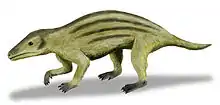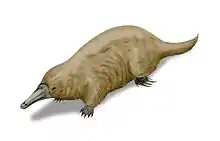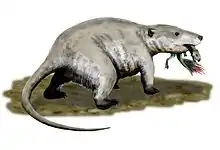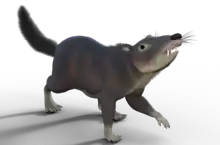Peligrotherium
Peligrotherium is an extinct dryolestoid, and the sole member of the family Peligrotheriidae, from the Paleocene of Patagonia, originally interpreted as a stem-ungulate (though it did co-exist with early meridiungulates). Its remains have been found in the Salamanca Formation.[1] It was a dog-sized mammal, among the largest of all dryolestoids, and closely related to mesungulatids, another lineage of large sized herbivorous dryolestoids.[2] A recent phylogenetic study finds it to be the sister taxon to Reigitherium.[3]
| Peligrotherium | |
|---|---|
| Scientific classification | |
| Kingdom: | Animalia |
| Phylum: | Chordata |
| Class: | Mammalia |
| Order: | †Dryolestida |
| Clade: | †Meridiolestida |
| Clade: | †Mesungulatoidea |
| Family: | †Peligrotheriidae Bonaparte et al., 1993 |
| Genus: | †Peligrotherium Bonaparte et al., 1993 |
| Species: | †P. tropicalis |
| Binomial name | |
| †Peligrotherium tropicalis Bonaparte et al., 1993 | |
References
- Peligrotherium at Fossilworks.org
- Guillermo Rougier, Laura Chornogubsky, Silvio Casadío, GIALLOMBARDO, Mammals from the Allen Formation, Late Cretaceous, Argentina, Cretaceous Research 2009(1):223-238 · February 2009 Impact Factor: 1.90 · DOI: 10.1016/j.cretres.2008.07.006
- Tony Harper; Ana Parras; Guillermo W. Rougier (2018). "Reigitherium (Meridiolestida, Mesungulatoidea) an enigmatic Late Cretaceous mammal from Patagonia, Argentina: morphology, affinities, and dental evolution". Journal of Mammalian Evolution. in press. doi:10.1007/s10914-018-9437-x.
This article is issued from Wikipedia. The text is licensed under Creative Commons - Attribution - Sharealike. Additional terms may apply for the media files.





